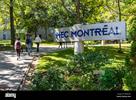JOPT2025
HEC Montreal, 12 — 14 May 2025
JOPT2025
HEC Montreal, 12 — 14 May 2025

Sustainability
May 14, 2025 10:30 AM – 12:10 PM
Location: TAL Gestion globale d'actifs (Green)
Chaired by Claudiane Ouellet-Plamondon
4 Presentations
-
 10:30 AM - 10:55 AM
10:30 AM - 10:55 AMPrioritizing Urban Flood Adaptation Strategies: A Multi-Criteria Approach to Sustainable Decision-Making
The increasing intensity and frequency of rainfall events due to climate change pose significant challenges to urban areas, particularly in managing stormwater and preventing flooding Traditional urban drainage systems, often referred to as gray infrastructure, were designed based on assumptions of stable weather patterns. However, as climate conditions evolve, these assumptions are no longer valid, leaving many existing systems underprepared for the higher volumes of water generated by more intense storms. This growing gap between infrastructure capacity and climate realities is leading to heightened flood risks, damaging properties, infrastructure, and ecosystems. In response, there is an urgent need to explore more sustainable and adaptive solutions for stormwater management. A promising alternative lies in the integration of blue and green infrastructure (BGI), which can complement or even replace traditional gray systems.
This research aims to assess BGI strategies to enhance the resilience of urban drainage systems against climate change impacts. The study focuses on a 20 km² watershed in Montreal, leveraging a previously calibrated Stormwater Management Model (PCSWMM) to reflect current climate conditions. Various BGI strategies will be evaluated using a multi-criteria decision analysis (MCDA) method known as PROMETHEE II. The study assesses the effectiveness of eight (8) BGI strategies. Using the PROMETHEE methods within the PyDecision Python framework, approximately 20 decision criteria, grouped in four categories (economic, technical, environmental and social), were applied to rank these adaptation strategies. The analysis also incorporates a variety of municipal funding scenarios, ranging from $1 million to $10 million, to evaluate the financial feasibility and scalability of each option.
By applying MCDA to infrastructure planning, this study provides data-driven insights to support municipal policymakers in designing cost-effective, and sustainable flood adaptation strategies.
-
 10:55 AM - 11:20 AM
10:55 AM - 11:20 AMDesign and Optimization of an Electronic Closed-loop Supply Chain Network Using a Multi-Objective Programming Model
In this talk, design and optimization of an electronic Closed-Loop Supply Chain (CLSC) network is discussed. This study introduces a new multi-objective mixed-integer linear programming model to optimize the CLSC network. The proposed model incorporates hybrid manufacturing facilities and Triple Bottom Line (TBL) objectives to maximize the total profit and social innovations while minimizing gas emissions. The application of the proposed model is shown in Ontario, Canada., Three solution approaches are used to solve the proposed optimization model. Finally, this study concludes with managerial insights and recommendations based on the research outcomes.
-
 11:20 AM - 11:45 AM
11:20 AM - 11:45 AMMulti-agent deep reinforcement learning with online and fair optimal dispatch of EV aggregators
The growing popularity of electric vehicles (EVs) and the unpredictable behavior of EV owners have attracted attention to real-time coordination of EVs charging management. This work presents a hierarchical structure for charging management of EVs by integrating fairness and efficiency concepts within the operations of the distribution system operator (DSO) while utilizing a multi-agent deep reinforcement learning (MADRL) framework to tackle the complexities of energy purchasing and distribution among EV aggregators (EVAs). At the upper level, DSO calculates the maximum allowable power for each EVA based on power flow constraints to ensure grid safety. Then, it finds the optimal efficiency-jain tradeoff (EJT) point, where it sells the highest energy amount while ensuring equitable energy distribution. At the lower level, initially, each EVA acts as an agent employing a double deep Q-network (DDQN) with adaptive learning rates and prioritized experience replay to determine optimal energy purchases from the DSO. Then, the real-time smart dispatch (RSD) controller prioritizes EVs for energy dispatch based on relevant EVs information. Findings indicate the proposed enhanced DDQN outperforms deep deterministic policy gradient (DDPG) and proximal policy optimization (PPO) in cumulative rewards and convergence speed. Finally, the framework’s performance is evaluated against uncontrolled charging and the first come first serve (FCFS) scenario using the 118-bus distribution system, demonstrating superior performance in maintaining safe operation of the grid while reducing charging costs for EVAs. Additionally, the framework's integration with renewable energy sources (RESs), such as photovoltaic (PV), demonstrates its potential to enhance grid reliability.
-
 11:45 AM - 12:10 PM
11:45 AM - 12:10 PMOptimizing the carbon footprint of 3D printed concrete
Concrete 3D printing proposes a prefabrication process allowing depositing material only where required. However, most mixture design methods struggle to perform to combine material performance and low carbon content, which is why a majority of 3D printing materials display high clinker contents. This study proposes a reproducible methodology for tailor-made 3D printing materials. Applied to a low-clinker quaternary blend, an iterative optimization process leads to a significant reduction of labor in material tuning. The optimization involves life cycle assessment and artificial neural networks as objective functions in the Pareto selection of best-performing solutions. Following the constitution of an 18-mixture database with 6 independent variables and 5 objective functions, printable mortars of different strength classes are designed within 2 to 4 active learning runs. Consequently, this optimum-driven technique allows it to rapidly converge toward low-carbon solutions for 3D printing, using local materials and custom characterization procedures.
